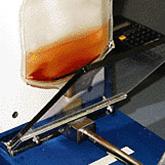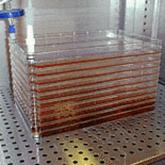Umbilical Cord Blood Transplantation
At the Masonic Cancer Center, Dr. John E. Wagner has helped lead Minnesota's Umbilical Cord Blood Transplantation Program to international prominence. He has been a critical part of this pioneering medical effort, using umbilical cord blood to perform the first transplant for the treatment of leukemia in 1990. The program's key elements are:
Cord Blood Research and Translational Development Clinical Care

Umbilical Cord Blood: A Precious Elixir
At the University of Minnesota Stem Cell Biology Laboratory, you can actually "hope" and see the energy that leads to cures: It's the wispy white wave under the tropical sunset. The white wisps are stem cells that have been spun out of the blood by a centrifuge. The sunset-colored fluid above them is plasma tinted with red blood cells.
Researchers at the world-renowned Stem Cell Institute at the University of Minnesota, are focused on that white line of stem cells because it holds the future promise for improving success rates of cord blood transplants.
Their hope is that under the right laboratory conditions, they can get the stem cells to naturally make more of themselves — thus increasing the dose available from a single donor to a transplant patient.
Increasing the stem cell dose is so important because study results obtained by Dr. John Wagner at the University of Minnesota unequivocally show that the success of a cord blood transplant is directly related to the number of stem cells transplanted.

Cell farming to replicate hematopoietic stem cells
Called "cell farming," laboratory production of stem cells is a protectant way to assure the high doses that would encourage faster engraftment and a better chance of survival.
This not only assures higher success rates in general, it also will make umbilical cord blood transplants more available to larger adults. But this wispy white line of cells, once put in an incubator and properly nourished, could change this.

The University of Minnesota: A Center for Cord Blood Transplant Research
University of Minnesota research centers have more NIH and other grant funding on umbilical cord blood stem cells and transplantation than any other institution in the world.